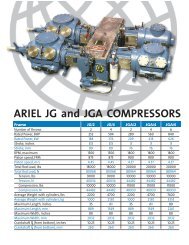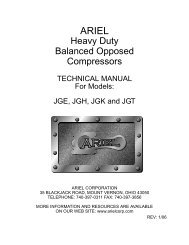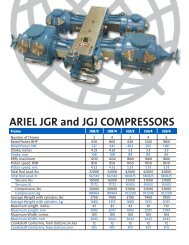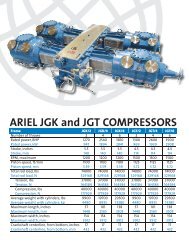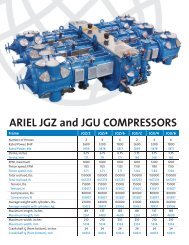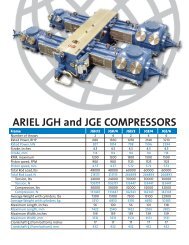Heavy Duty Balanced Opposed Compressors
Heavy Duty Balanced Opposed Compressors
Heavy Duty Balanced Opposed Compressors
Create successful ePaper yourself
Turn your PDF publications into a flip-book with our unique Google optimized e-Paper software.
FOR MODELS: JG AND JGA SECTION 5 - MAINTENANCE<br />
Piston and Rod - Removal<br />
!<br />
CAUTION<br />
TO PREVENT PERSONAL INJURY, ENSURE THAT COMPRESSOR<br />
CRANKSHAFT CANNOT BE TURNED BY THE DRIVER OR COMPRES-<br />
SOR CYLINDER GAS PRESSURE DURING MAINTENANCE: -- ON<br />
ENGINE-DRIVEN COMPRESSORS, REMOVE THE CENTER COUPLING<br />
OR LOCK THE FLYWHEEL. -- ON ELECTRIC MOTOR-DRIVEN COM-<br />
PRESSORS, IF IT IS INCONVIENIENT TO DETACH THE DRIVER FROM<br />
THE COMPRESSOR, THE DRIVER SWITCH GEAR MUST BE LOCKED<br />
OUT DURING MAINTENANCE.<br />
BEFORE PERFORMING ANY MAINTENANCE, COMPLETELY VENT<br />
SYSTEM. BEFORE REMOVING A CYLINDER HEAD, BACK OFF ALL<br />
CAPSCREWS 1/8" (3 mm). MAKE SURE THE HEAD IS LOOSE AND THE<br />
CYLINDER IS COMPLETELY VENTED.<br />
1. Remove the crosshead guide side covers and the cylinder head. The cylinder<br />
head is to be loosened first to the Caution! instructions above.<br />
2. Move the crosshead to its inner dead center position. Back off, but do not<br />
remove, the crosshead nut set screws. Loosen the crosshead nut with the special<br />
slugging wrench, (see Figure 7-1: on page 7-3) and a slugging hammer. Use<br />
the open-end wrench for hex nuts and the peg wrench for round nuts.<br />
3. Remove the cylinder head. In the case of tandem cylinders where the outboard<br />
cylinder bore is smaller than the inboard bore, it is necessary to remove the outboard<br />
cylinder. Support such cylinders during removal and installation, as to not<br />
put excessive weight on the piston and rod assembly which might cause bending.<br />
4. Use the Piston Nut Spanner and speed wrench to screw the piston and rod<br />
assembly out of the crosshead. The two dowels on the Piston Nut Spanner fit<br />
the holes in the piston nut. Turn the crosshead nut off the piston rod.<br />
5. As the piston leaves the cylinder, be careful in handling the piston rings. Despite<br />
their toughness in service, rings are fragile with regard to removal. Always handle<br />
them with clean tools and hands protecting the rings from nicks, marring,<br />
and bending. Move the piston out of the cylinder until a fraction of the first ring<br />
clears the cylinder. Encircle the ring by hand (use a band for larger sizes) until it<br />
is clear and remove it. Use this same procedure to remove the succeeding rings<br />
and wear band.<br />
6. Slide the piston rod assembly out of the head end. The threaded crosshead end<br />
of the rod is 1/8 inches (3 mm) smaller in diameter than the inside diameter of<br />
the packing. Using extreme care, slowly slide the piston rod through the packing<br />
to avoid damaging the rod threads or the packing rings.<br />
PAGE 5 - 18 11/01





